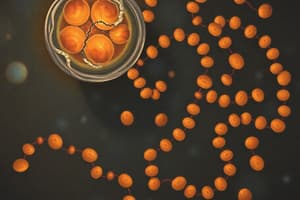Podcast
Questions and Answers
What is the primary product of the preparatory reaction after glycolysis?
What is the primary product of the preparatory reaction after glycolysis?
- O2
- FADH2
- Pyruvate
- Acetyl-CoA (correct)
How many NADH molecules are produced per acetyl-CoA during the Krebs cycle?
How many NADH molecules are produced per acetyl-CoA during the Krebs cycle?
- 2
- 1
- 4
- 3 (correct)
Where does the Krebs cycle occur in eukaryotic cells?
Where does the Krebs cycle occur in eukaryotic cells?
- Mitochondrial matrix (correct)
- Cytoplasm
- Cell membrane
- Ribosomes
What is the final electron acceptor in the electron transport chain?
What is the final electron acceptor in the electron transport chain?
What byproduct is generated from the conversion of pyruvate during the preparatory reaction?
What byproduct is generated from the conversion of pyruvate during the preparatory reaction?
How many ATP molecules are generated per glucose molecule during the electron transport chain?
How many ATP molecules are generated per glucose molecule during the electron transport chain?
What role does NADH play in the electron transport chain?
What role does NADH play in the electron transport chain?
Which molecule is formed when acetate binds to Coenzyme A?
Which molecule is formed when acetate binds to Coenzyme A?
What type of reaction does the Krebs cycle represent?
What type of reaction does the Krebs cycle represent?
Which organisms acquire carbon from organic compounds?
Which organisms acquire carbon from organic compounds?
Which of the following is NOT a function of phosphorus in microbial growth?
Which of the following is NOT a function of phosphorus in microbial growth?
What is a source of nitrogen for most bacteria?
What is a source of nitrogen for most bacteria?
Which classification describes organisms that cannot survive in the presence of oxygen?
Which classification describes organisms that cannot survive in the presence of oxygen?
Which of the following elements is essential for the synthesis of cysteine?
Which of the following elements is essential for the synthesis of cysteine?
What type of organisms can grow with or without oxygen but cannot use it?
What type of organisms can grow with or without oxygen but cannot use it?
Which of the following is a method by which heterotrophs acquire carbon?
Which of the following is a method by which heterotrophs acquire carbon?
What is a unique characteristic of microaerophiles?
What is a unique characteristic of microaerophiles?
What role does nitrogen fixation play in microbial growth?
What role does nitrogen fixation play in microbial growth?
Which of these sources do not provide phosphorus to microbes?
Which of these sources do not provide phosphorus to microbes?
What is a significant consequence of biofilm-related infections in healthcare?
What is a significant consequence of biofilm-related infections in healthcare?
What is the principle behind the 'spread plate method' of diluting bacterial samples?
What is the principle behind the 'spread plate method' of diluting bacterial samples?
Which method uses a statistical table to estimate the number of bacteria?
Which method uses a statistical table to estimate the number of bacteria?
Which of the following methods involves measuring metabolic activity to estimate bacterial growth?
Which of the following methods involves measuring metabolic activity to estimate bacterial growth?
How is the number of bacteria per milliliter calculated using a direct microscopic count?
How is the number of bacteria per milliliter calculated using a direct microscopic count?
What type of measurement method would you use if you wanted to assess bacterial growth indirectly through cloudiness?
What type of measurement method would you use if you wanted to assess bacterial growth indirectly through cloudiness?
What is the primary difference between aerobic and anaerobic respiration?
What is the primary difference between aerobic and anaerobic respiration?
Which process does not occur in anaerobic respiration?
Which process does not occur in anaerobic respiration?
What defines exponential growth in bacterial populations?
What defines exponential growth in bacterial populations?
What does the generation time refer to in bacterial populations?
What does the generation time refer to in bacterial populations?
Which formula is used to calculate the theoretical growth of a bacterial population?
Which formula is used to calculate the theoretical growth of a bacterial population?
How do binary fission and budding compare in terms of the size of daughter cells?
How do binary fission and budding compare in terms of the size of daughter cells?
Which statement correctly describes the process of fermentation?
Which statement correctly describes the process of fermentation?
In which manner do bacteria primarily reproduce through binary fission?
In which manner do bacteria primarily reproduce through binary fission?
What is the key characteristic of linear growth in bacterial populations?
What is the key characteristic of linear growth in bacterial populations?
Which of the following is true about the generation times of most bacteria?
Which of the following is true about the generation times of most bacteria?
Where does growth occur most effectively?
Where does growth occur most effectively?
What is the role of superoxide dismutase (SOD) in aerobic organisms?
What is the role of superoxide dismutase (SOD) in aerobic organisms?
What condition is necessary for the presence of enzymes like catalase and SOD?
What condition is necessary for the presence of enzymes like catalase and SOD?
What happens in organisms lacking enzymes to neutralize harmful forms of oxygen?
What happens in organisms lacking enzymes to neutralize harmful forms of oxygen?
What is the outcome of hydrogen peroxide in cells if not neutralized?
What is the outcome of hydrogen peroxide in cells if not neutralized?
Which of the following statements is true about aerobic organisms?
Which of the following statements is true about aerobic organisms?
What type of radicals can oxygen produce that are harmful to cells?
What type of radicals can oxygen produce that are harmful to cells?
What does catalase specifically convert?
What does catalase specifically convert?
What generally occurs in regions where oxygen has no effect on growth?
What generally occurs in regions where oxygen has no effect on growth?
What is the consequence of producing toxic forms of oxygen without neutralizing enzymes?
What is the consequence of producing toxic forms of oxygen without neutralizing enzymes?
Flashcards are hidden until you start studying
Study Notes
Preparatory Reaction (Pyruvate Oxidation)
- Occurs after glycolysis, before the Krebs cycle.
- Each pyruvate molecule is converted into acetyl-CoA.
- Does not require oxygen.
- One carbon atom is released from pyruvate (3C) as CO2.
- Two NADH "hydrogen transport" molecules are produced.
- The remaining 2C molecules (acetate) bind to coenzyme A to form acetyl-CoA.
Krebs Cycle
- Turns twice per glucose molecule because glycolysis produces two pyruvate molecules.
- Occurs in:
- Mitochondrial matrix in eukaryotes
- Cytoplasm of prokaryotes
- For each acetyl-CoA entering the cycle, the products are:
- 3 NADH (electron carrier)
- 1 FADH2 (electron carrier)
- 1 ATP
- 2 CO2 (waste product)
Electron Transport Chain (ETC)
- Located in:
- Inner mitochondrial membrane in eukaryotes.
- Plasma membrane in prokaryotes.
- Final step in aerobic respiration.
- NADH transports hydrogen to the ETC membrane system.
- Most ATP is produced here:
- Electrons from NADH and FADH2 are passed through protein complexes, creating a proton (H+) gradient across the membrane.
- This gradient drives ATP synthase, synthesizing ATP from ADP and Pi.
- Oxygen serves as the final electron acceptor, combining with protons and electrons to form water.
- Generates 32-34 ATP per glucose.
NAD+ in the ETC
- Reduced to NADH during:
- Glycolysis
- Preparatory reaction
- Krebs cycle.
- NADH donates electrons to the first complex of the ETC.
- As electrons pass down the chain, protons (H+) are pumped across the membrane, contributing to the proton gradient that drives ATP synthesis.
Respiration Processes Summary
- Aerobic Respiration: Glycolysis -> Krebs Cycle -> ETC (using oxygen as the final electron acceptor)
- Anaerobic Respiration: Glycolysis -> Krebs Cycle -> ETC (using a non-oxygen acceptor)
- Fermentation: Glycolysis -> Fermentation (conversion of pyruvate to lactic acid, ethanol, etc.)
Microbial Growth
- Linear Growth: Constant growth rate, adding the same number of cells per unit time.
- Exponential Growth: Occurs by multiplication, not addition. Population doubles at regular intervals.
- Rapid increase.
- Population size doubles with each round of division.
- Growth rate changes proportionally to the prior size.
Generation Time
- Time it takes for a bacterial population to double in number.
- Varies between bacteria species.
- Most bacteria have a generation time of 1-2 hours.
- Ranges from 20 minutes to 24 hours.
Theoretical Growth Calculation
- Formula:
- Nt = N0 x 2n Nt = Number of cells after a certain time. N0 = Initial number of cells. n = Number of generations (calculated by dividing total time by generation time).
Bacterial Reproduction
- Binary Fission:
- Most common method.
- Parent cell duplicates its DNA and divides into two identical daughter cells.
- Division is symmetrical.
- Budding:
- Less common in bacteria.
- A small outgrowth (bud) forms on the parent cell.
- The bud grows until it detaches, becoming a new, smaller daughter cell.
- Division is asymmetrical.
Osmotic Pressure
- Maintaining proper osmotic pressure is essential for cells to prevent water loss or gain, affecting their ability to grow and survive.
Chemical Growth Requirements
- Four main elements needed in large amounts:
- Carbon: Structural backbone of all organic molecules.
- Heterotrophs: Use organic molecules as energy (sugar, protein, lipids).
- Autotrophs: Use CO2 to make their own organic molecules.
- Nitrogen: Components of amino acids, DNA, RNA, and ATP.
- Most bacteria decompose protein material for nitrogen.
- Some bacteria use N2 in nitrogen fixation.
- Some use N2+ or NO3- from organic material.
- Sulfur: Important for the synthesis of some acids (like cysteine) and vitamins.
- Required for protein structure and enzyme function.
- Some bacteria use SO42- or H2S.
- Most decompose protein for sulfur.
- Phosphorus: Essential for the formation of DNA, RNA, ATP, and phospholipids.
- Found in membranes (phospholipid bilayer).
- Carbon: Structural backbone of all organic molecules.
Acquisition of Essential Elements
- Carbon:
- Heterotrophs get carbon from organic compounds (like glucose).
- Autotrophs fix carbon from CO2 in the atmosphere.
- Nitrogen: Acquired from ammonia (NH3), nitrates (NO3-) or atmospheric nitrogen (N2) in nitrogen-fixing bacteria.
- Sulfur: Obtained from sulfate (SO42-), hydrogen sulfide (H2S), or organic sulfur-containing compounds.
- Phosphorus: Taken up as phosphate ions (PO43-) from the environment.
Oxygen Requirements
- Obligate Aerobes: Require oxygen for growth and cannot survive without it.
- Obligate Anaerobes: Cannot survive in the presence of oxygen, as it is toxic to them.
- Facultative Anaerobes: Can grow with or without oxygen.
- Aerotolerant Anaerobes: Tolerate oxygen but cannot use it.
- Microaerophiles: Require oxygen levels lower than air.
Enzymes for Oxygen Tolerance
- Superoxide Dismutase (SOD): Converts toxic superoxide radicals (O2-) into hydrogen peroxide (H2O2) and oxygen (O2).
- Catalase: Converts hydrogen peroxide (H2O2) into water (H2O) and oxygen (O2).
- Peroxidase: Converts hydrogen peroxide (H2O2) into water (H2O) using a reducing agent (like NADH or glutathione).
Biofilms
- Communities of microorganisms encased in a slimy matrix.
- Adhere to surfaces, forming a protective layer.
- Important in various environments, including:
- Aquatic ecosystems
- Industrial settings
- Human body.
Biofilm Formation Steps
- Attachment: Microorganisms attach to a surface.
- Colonization: Microorganisms start multiplying and form a community.
- Maturation: The biofilm grows and develops a complex architecture.
- Detachment: Some microorganisms detach from the biofilm, potentially spreading to new locations.
Biofilm Benefits
- Protection: Shield microorganisms from:
- Antimicrobials
- Immune cells.
- Nutrient sharing: Facilitate the exchange of nutrients and resources.
- Survival: Enhance the survival of microorganisms in challenging environments.
Biofilm Problems:
- Infections: Cause chronic and persistent infections, difficult to treat.
- Antibiotic resistance: Can increase antibiotic resistance in bacteria.
- Industrial damage: Can cause biofouling in pipes, equipment, and other infrastructure.
Biofilm Removal Strategies
- Mechanical removal: Use physical methods to remove biofilms (e.g., scrubbing, brushing).
- Chemical treatment: Use disinfectants or antimicrobial agents to kill or inhibit biofilm formation.
- Bioaugmentation: Introduce beneficial microorganisms to compete with biofilm formers and degrade biofilm components.
Direct Methods of Measuring Cell Growth
- Plate Count: Count colonies on plates that have 30-300 CFUs.
- Serial Dilution: The original inoculum is diluted to ensure the right number of colonies.
- Spread Plate Method: Bacteria are diluted in liquid broth and spread directly on the surface of an agar plate.
- Pour Plate Method: Bacteria are diluted into soft agar and poured onto an agar plate.
- Filtration: A solution is passed through a filter that collects bacteria. The filter is transferred to a Petri dish and grows as colonies on the surface.
- Most Probable Number (MPN) Method:
- Inoculate multiple tubes with different sample volumes.
- Count positive tubes.
- Compare with a statistical table.
- Direct Microscopic Count:
- A volume of bacterial suspension is placed on a slide with a grid.
- Average number of bacteria per viewing field is calculated.
- Uses a Petroff-Hausser cell counter.
Indirect Methods of Measuring Cell Growth
- Turbidity: Measurement of cloudiness with a spectrophotometer.
- Metabolic Activity: Amount of metabolic product (color change) is proportional to the number of bacteria.
- Dry Weight: Bacteria are filtered, dried, and weighed (used for filamentous organisms).
Controlling Microbial Growth: Techniques and Considerations
- Sterilization: Elimination of all microorganisms, including bacteria, viruses, and spores.
- Disinfection: Elimination of most pathogenic microorganisms from non-living surfaces.
- Antisepsis: Elimination of most pathogenic microorganisms from living tissues.
- Sanitization: Reduction of microbial populations to a safe level.
Factors Influencing Microbial Growth Control
- Type of microorganism: Different microorganisms have varying sensitivities to antimicrobial agents.
- Temperature: High temperatures generally kill microorganisms more effectively than low temperatures.
- Time: Longer exposure times generally increase the effectiveness of antimicrobial agents.
- pH: Microorganisms have optimal pH ranges for growth.
- Concentration of antimicrobial agent: Higher concentrations generally increase effectiveness.
- Presence of organic matter: Organic matter can interfere with the effectiveness of antimicrobial agents.
Physical Control Methods
- Heat:
- Moist Heat: Kills microorganisms by denaturing proteins (e.g., boiling, autoclaving).
- Dry Heat: Kills microorganisms by oxidizing cellular components (e.g., incineration, oven sterilization).
- Radiation:
- Ionizing Radiation: Penetrates deeply and damages DNA (e.g., gamma rays, X-rays).
- Non-ionizing Radiation: Damages DNA (e.g., UV light).
- Filtration: Physically removes microorganisms from liquids or gases.
- Low Temperatures: Inhibit microbial growth (e.g., refrigeration, freezing).
- Desiccation (Drying): Removes water, inhibiting microbial growth.
Chemical Control Methods
- Disinfectants: Used on non-living surfaces.
- Phenolics: Effective against a wide variety of microorganisms.
- Halogens: Oxidize cellular components (e.g., chlorine, iodine).
- Alcohols: Disrupt cell membranes.
- Heavy Metals: Inhibit enzyme activity.
- Antiseptics: Used on living tissues.
- Iodine: Broad-spectrum antimicrobial.
- Alcohol: Disrupts bacterial cell membranes.
- Hydrogen Peroxide: Oxidizing agent.
- Antibiotics: Chemical substances produced by microorganisms or synthetically that inhibit bacterial growth.
Microbial Control in Healthcare Settings
- Hand Hygiene: Critical for preventing the spread of infections.
- Disinfection of Surfaces: Regularly disinfect surfaces to reduce microbial populations.
- Sterilization of Medical Devices: Sterilize medical devices to ensure they are free of microorganisms.
- Use of Personal Protective Equipment (PPE): Protects healthcare workers from exposure to infectious agents.
- Infection Control Practices: Follow standardized infection control protocols to prevent the spread of infections.
Importance of Microbial Control
- Public Health: Prevent the spread of infectious diseases.
- Food Safety: Ensure food is safe for consumption.
- Water Safety: Keep water supplies safe from contamination.
- Industrial Processes: Prevent microbial spoilage of products.
- Healthcare: Reduce the incidence of healthcare-associated infections.
Studying That Suits You
Use AI to generate personalized quizzes and flashcards to suit your learning preferences.



